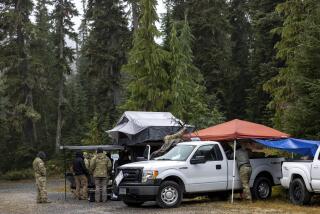Crash Kills First Female F-14 Combat Pilot : Aviation: Lt. Kara Hultgreen was attempting carrier landing off California. She loved the Navy, her sister says.
- Share via
SAN DIEGO — Navy Lt. Kara Hultgreen, who had dreamed as a teen-ager of being an astronaut and then became the first woman qualified as an F-14 combat pilot, was killed when her plane crashed during a training mission, the Navy announced Wednesday.
Hultgreen, 29, was attempting to land on the carrier Abraham Lincoln off Southern California when her F-14 Tomcat crashed into the ocean Tuesday afternoon. The fighter’s radar officer ejected and was rescued with only minor injuries but an extensive search failed to recover the plane or Hultgreen’s body.
Hultgreen, a graduate of the University of Texas, was among the first group of women pilots to apply for combat training when the restriction on women flying combat aircraft was lifted by then-Secretary of Defense Les Aspin in April, 1993.
“She was a wonderful, giving, generous person who loved flying, loved the Navy and loved her country,” said her sister Dagny Hultgreen, a television journalist.
A high school basketball and tennis star and later an expert surfer, Hultgreen gave several interviews when she qualified in August as an F-14 pilot. She stressed both the exhilaration and the danger of flying the F-14.
“I mean, it’s fun to go fast and light up the afterburner and pull out of Gs and zip around the clouds,” she told KNSD-TV in San Diego. “I don’t think I’ve mastered it quite yet. It’s going to take a lot of hours and a lot of training.”
She recalled the thrill of making her first four landings on a carrier:
“I barely remember my first four traps because all I could think of was how can I work the rest of my life to buy this drug. It’s just an adrenaline rush.”
Although she and other women pilots received much the same training as men, their career options had been limited. In fact, before the restriction was lifted, Navy officials had suggested that Hultgreen leave the Navy because there were far more pilots than needed assigned to the planes women were allowed to fly.
Hultgreen was born in Connecticut. Her family moved frequently during her youth. She remarked once about being shocked when the family moved during her teen-age years from Canada to Texas.
In Canada, high school girls had been allowed to play any sport they chose. In Texas, she noted, girls were expected to become football cheerleaders.
“I just never noticed being treated any differently when I was in Canada,” she told the Navy publication Compass. “The whole girl-guy issue was never an issue.”
Hultgreen’s mother, Sally Spears, a lawyer in San Antonio, said her daughter had wanted to be an astronaut but then decided that flying an aircraft was more exciting.
She joined the Navy while a senior at the University of Texas and went on active duty after receiving her degree in aerospace engineering in 1987. Before going to F-14 school, Hultgreen had flown a jet designed to jam the electronic gear of an enemy.
Spears said she realized that flying was dangerous but had full confidence in her daughter.
“Kara studied, she trained, she loved it so much,” Spears said. “She never complained about anything. She was so confident that I wasn’t allowed to worry about her.”
Hultgreen came from a family of high achievers: Her mother was one of the first women admitted to the University of Texas law school, one sister worked as a television reporter in Pittsburgh and Los Angeles and is now doing independent production for the show “The Crusaders,” and a second sister formerly owned a fitness salon and now works with a movie production company in Los Angeles.
Kara was the youngest of the three daughters. “She was our baby,” Spears said.
Her father, who is divorced from Spears, is a paper company executive in Appleton, Wis.
Capt. Mark Grissom, commander of the Navy’s fighter wing for the Pacific fleet, based at Miramar Naval Air Station in San Diego, said an investigation is under way to determine the cause of the crash and whether Hultgreen ejected. One theory is that the plane may have stalled at 200 feet above the ocean as Hultgreen attempted the day landing.
“This unfortunate mishap should in no way (harm) the effectiveness of women in combat, the integration of women into combat units or their gaining the respect of their male colleagues,” Grissom told reporters. The F-14 is one of several combat aircraft that had been off-limits to women before Aspin’s action.
Grissom said Hultgreen had initially failed to qualify as an F-14 pilot, in a grueling process that includes 10 daytime landings on a carrier and six night landings. One in four pilots fail on the first attempt at qualifying, Grissom said.
In her second attempt, in August, Hultgreen qualified. Another woman pilot, Lt. Carey Lohrenz, has also qualified in the F-14, but Hultgreen did so first, Navy officials said.
“She did a very fine job,” Grissom said. “Every person in that squadron feels a great sense of loss. She was upholding every aspect of what is expected of an F-14 carrier pilot.”
Recently Hultgreen had called one of her sisters to discuss how the family should be notified if she died in the line of duty.
“She was never under any delusion that it couldn’t happen to her,” Dagny Hultgreen said. “She was worried about how it would affect us if she died. She had such a love and passion for her family.”
Spears said the family is bearing up well in the wake of the tragedy. “We’re a close family and we kept in touch,” she said. “We had planned to be part of each other’s lives for a long time.”
Dagny Hultgreen, in a telephone interview, said her sister was so involved with her flying, which requires constant training and carrier missions, that she had not had time for a social life or to consider marriage. Because of her surfing, she was called “Flipper” by other members of the Fighting Blacklions squadron.
Journalists who interviewed her remembered Hultgreen as confident and personable, with a quick wit and bright laugh.
“She was one of those women you met and you’re convinced that she could be President someday,” said KFMB-radio reporter Eva Beim. “She was so strong, beautiful and dedicated, so poised for someone so young. She was an All-American recruiting poster.”
In a Compass article, Hultgreen had recalled being frustrated before Aspin lifted the restriction on women in combat.
“We dropped bombs, we shot rockets, we did air-to-air gunnery,” Hultgreen told the Compass. “We did carrier qualifications, we did dogfighting, everything. It was frustrating at the time to have done so well and have very limited options just because I was female.”
“The F-14 is a dangerous job, that’s true,” she said in another interview. “It’s not for everyone and going into combat isn’t for everyone.”
More to Read
Inside the business of entertainment
The Wide Shot brings you news, analysis and insights on everything from streaming wars to production — and what it all means for the future.
You may occasionally receive promotional content from the Los Angeles Times.










